Author: Four Pillars Translator: Bai Ding, Xian Ran
Note: Four Pillars is a Korean investment and research institution. The team has in-depth insights into market and industry development trends. Based on their own research and judgment, they have invested in many star projects such as INJ, SUI, Ethena, Virtuals, and Hyperliquid. This article is a research report that explains their investment logic and reasons for holding positions. Four Pillars members deeply express their views on future market development. I recommend you to read it.
Whenever we talk about our research in blockchain, there are always people who ask: "What coins should I buy now?" "Which projects are worth investing in?" In fact, the responsibility of VC researchers is to analyze blockchain-related technologies and determine market trends, rather than to provide investment advice, so we are usually reluctant to answer such questions.
But what’s special about the Four Pillars research team is that we are both industry observers and deep participants in the crypto market, so instead of giving vague “investment advice”, we would rather directly disclose our position structure and explain the investment logic.
You may be curious: What assets do these Four Pillars researchers who are immersed in blockchain research all day long hold? What is the basis for their decisions? Before explaining each investment target in detail, we will use a chart to visually present the team's overall holdings:
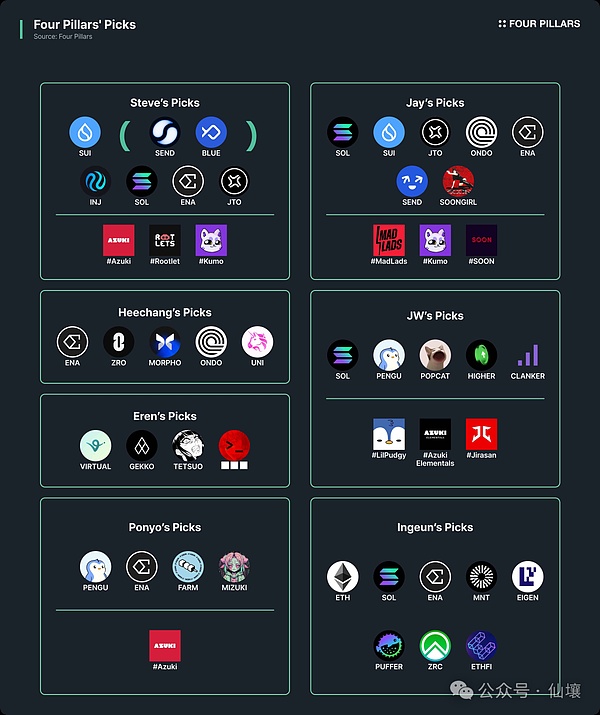
From the above chart, we can easily find that the team's holdings show diversified distribution characteristics, covering multiple tracks and ecosystems. Next, we will analyze the investment logic of each researcher one by one, as well as their judgment on the future potential of these assets.
Steve: Ethereum’s dominance is declining, so focus on products with PMF that are already in the market
Portfolio: Sui, Injective, Jito, Ethena, Azuki, Rootlets, Kumo
Smart contract platforms are no longer winner-take-all
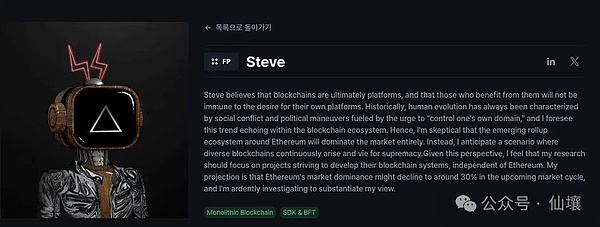
Four Pillars was established in May 2023. At that time, there were a number of new public chains that were regarded as challengers to Ethereum. They all collapsed after the Terra collapse and the FTX incident. At that time, Ethereum firmly occupied the market dominance. But I was sure at that time: in the next bull market, Ethereum's market share will definitely fall back to around 30%. There are three core logics:
First, the scale of users entering the market in the new cycle will be far greater than in the past;
Second, incremental users will inevitably bring diversified value orientations;
Third, Ethereum cannot meet the needs and preferences of all groups.
The Ethereum ecosystem places the "concept of decentralization" as the highest priority, which makes me notice its key contradiction - to achieve true "Mass adoption", it must be compatible with user groups that do not regard decentralization as the ultimate value.
Of course, the essence of blockchain technology requires "a certain degree of decentralization", but I believe that not all scenarios require Ethereum-level decentralization. On the contrary, other value dimensions such as execution efficiency, compliance framework, user experience, etc. may have higher priority than decentralization. This diversity of value orientation will continue to stimulate market demand for other public chains besides Ethereum.
Subsequent market performance has verified my judgment: compared with 2023, the current market share of Ethereum has stabilized in the range of 20-30%. As of January 9, 2025, the market value of Ethereum is 398.5 billion US dollars, and the total market value of the entire crypto market is 1.35 trillion US dollars.
And I think the biggest problem of Ethereum ecosystem is not the technical level, but its arrogant attitude that "everything will eventually belong to Ethereum". To some extent, this runs counter to the decentralization concept they advocate. The open world that blockchain tries to build will never run according to the will of any particular group. Therefore, I think it is almost impossible for the smart contract platform field to form a winner-takes-all situation in the future.
Because anyone can create a new public chain, innovation may emerge at any time. Over time, more and more people will become familiar with blockchain technology, and the threshold for using new public chains will continue to decrease. Smart contract platforms are likely to maintain fierce competition. Of course, this does not mean that we will return to the era of random chain issuance. In the future, the number of major public chains participating in the competition may decrease, but new frameworks and platforms will continue to emerge, and the existing leading public chains will continue to improve their infrastructure.
Based on this judgment, new blockchain frameworks and technologies have always been my focus. My interest in Sui will continue until 2025, and it is at the forefront of the field of "new infrastructure technology". In addition, I believe that public chains like Solana and Injective, which rely on their respective advantages to build unique ecosystems, will eventually gain greater market attention - Solana is known for its strong community foundation and scalability comparable to Sui, while Injective is known for its extremely fast transactions, flexible business expansion capabilities and unique token economic model.
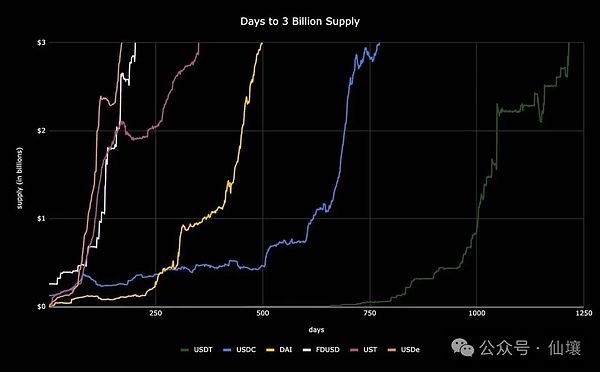
Source: X (@leptokurtic_)
New opportunities for existing tracks
When asked "Which areas of the blockchain industry have achieved PMF", my answer is always the three cornerstones of exchanges, stablecoins and public chains. Before exploring unproven emerging market opportunities, deepening existing mature tracks and iterating technologies are also valuable directions.
Taking the stablecoin track as an example, its development space is far from reaching its peak. If we can build a differentiated model while avoiding historical risks, such as the defects in Terra's model design, it is entirely possible to generate new market demand. The rise and fall of Terra has proved that in addition to USDT and USDC, there is indeed a real market demand for Web3 native stablecoins .
This is exactly the core logic of why I am optimistic about Ethena - it has built high returns through funding rates, and compared with USDT and USDC in terms of underlying architecture, it has formed an essential innovation. Ethena's breakthrough lies in: in addition to the basic attraction of "high interest rates", it continues to expand the application scenarios of USDe, such as the integration of USDe with Bybit, which can be used as a collateral asset to trade perpetual contracts, which is a good example.
Although Ethena's funding rate income may narrow in a bear market, the project has begun to develop derivatives such as USDtb to hedge against market fluctuations, demonstrating a mature risk management awareness.
Based on the above reasons, I pay close attention to the innovative practices of three types of tracks that have been verified by the market: exchanges, stablecoins, and public chains. Take Hyperliquid as an example (although I have not yet held a position), which has innovated the derivatives trading experience through the order book model, showing similar innovative genes to Ethena. This type of "blue ocean in the red ocean track" project has always been my focus of observation.
What is a real community?
"Community" is perhaps one of the most abused words in the Web3 field. Almost all projects claim to be "serving the community", but in most cases, the community is just their "liquidity outlet" or "threshold for listing" - this hypocritical community narrative has now been seen through by most retail investors.
I am not denying the value of airdrops. As a cold start tool, airdrops are indeed an effective means of building an initial community. But airdrops are only a means of starting. Only when users feel something other than the price of the currency can the community truly survive. Blockchain is similar to a country in some ways, but it lacks mandatory constraints, making it closer to religion.
In addition to economic incentives, the only thing that can bring people together spontaneously is a fascinating narrative, which is why Ethereum and Solana have strong (even slightly fanatical) communities - they have experienced the collapse of the DAO attack and the FTX incident respectively, but have been reborn from the ashes and formed a unique community narrative.
In the NFT field, Azuki is one of the few projects that has built this kind of "narrative". Despite its amazing start, the Azuki team and founder Zagabond have gone through many tests in the past three years of operation . It is because they overcame these challenges that they have built a solid community foundation today. This shows that a real community cannot be built by spending money. People need to gain a sense of belonging through "experiences of sharing weal and woe" in addition to economic incentives.
Based on this, I am optimistic about projects that have established communities of this nature, and believe that projects with a solid community foundation will perform well in the industry. After all, code can be forked, but the community cannot be copied.
Jay: Which projects will really drive Adpotion?
Portfolio: Solana, Sui, Jito, Ondo Finance, Ethena, Send, SOON Girl, MadLads, Kumo, SOON
Virtual machines other than EVM
2024 is a critical turning point for the development of the non-EVM ecosystem. Taking Solana as an example, multiple DeFi projects and consumer applications under the SVM ecosystem, such as Pump.fun, Photon, Daos.fun, etc., have shown performance comparable to or even surpassing the top projects in the Ethereum ecosystem. Especially in the field of stablecoin payments, Solana has successfully integrated mainstream companies such as Visa and Shopify, greatly increasing the market's expectations for its mass adoption prospects.
In addition to Solana, Sui continues to expand its ecosystem with "Move on SUI" and achieves extremely low transaction latency by introducing breakthrough technological innovations. In addition, the release of the SuiPlay0X1 handheld game console designed specifically for Sui marks the explosive growth of its gaming ecosystem.
From a macro perspective, an obvious trend is that more and more ecosystems are gradually getting rid of the EVM framework , developing or integrating their own exclusive virtual machines, and building customized ecosystems . Although Ethereum, as the first smart contract platform, has indeed led the industry development and spawned many innovative ideas, I am optimistic that non-EVM public chains will surpass the Ethereum ecosystem. The root cause is that EVM lacks a clear mission orientation and has many inherent defects.
We are currently witnessing the rise of diverse virtual machines, and these innovations are breaking through the boundaries of the EVM ecosystem. Ultimately, the diversity and quality of applications will depend on the level of development of virtual machines. The key challenge is how to give full play to the advantages of each VM and build full-stack applications optimized for specific scenarios. Looking ahead to 2025, non-EVM infrastructure and its combined innovations may usher in a broader development space to meet the evolving needs of the market.
Truly understand the RWA project with Web2 and Web3 synergy
What is the greatest value of blockchain? I think it is its ability to tokenize assets. Tokenization can make any asset liquid, which can bring many advantages, such as improving capital efficiency and accessibility, building fast infrastructure, realizing smart contract automation, and enhancing compliance and transparency. The long-term mass adoption problem faced by the crypto industry must fundamentally break through the tokenization mechanism.
However, despite numerous projects attempting to tokenize various assets over the years, we have seen few successful cases. The root cause is that these projects have failed to build a convincing value transfer system and demonstrate the advantages of tokenization. As traditional industries continue to gain interest in the crypto space, the projects that can effectively implement tokenization will be the most popular in the future.
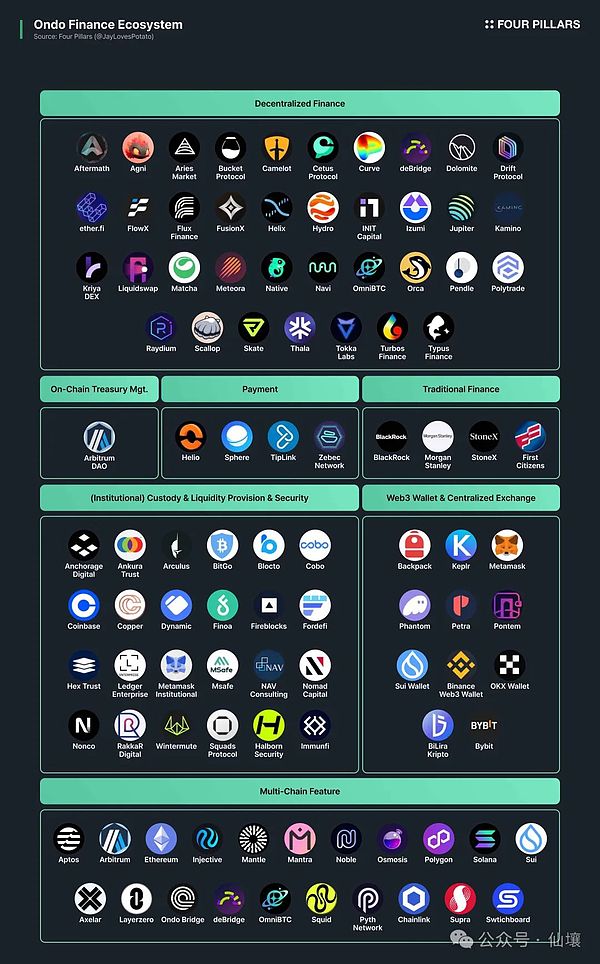
Source: How Ondo Finance Is Redefining Tokenization to Lead the RWA Market
Let’s take Ondo Finance, the leader in the RWA field, as an example. Ondo not only tokenizes U.S. Treasury products on the blockchain, but also achieves two major goals by building a partnership across the Web2 and Web3 ecosystems:
1) Ensure that assets are protected by institutional investors;
2) Maximize its utility by interacting with various protocols.
This strategy can create value for Web2 and Web3 investors. By deeply understanding the characteristics of the off-chain and on-chain fields and using this as a basis to achieve organic expansion and collaborative innovation between the two, such projects will gain more and more attention in the next few years.
Projects that create real value for the community
The launch of Hyperliquid can be said to be revolutionary. Without external financing, the team relied entirely on internal resources to develop and grow with the community. Despite circulating more than 30% of the tokens at the TGE, the project still broke through the FDV of $10 billion in just one week. The subsequent surge in the price of the HYPE token triggered a heated response. This was like a protest against the traditional model of the industry, highlighting the importance of community-friendly projects.
So, what is a truly community-friendly project? In short, it is a project that can provide substantial value to the community. In my opinion, this value can be achieved through two major channels: economic benefits and cultural identity.
First, let’s look at the economic benefits. Given the sensitivity of the Web3 ecosystem to incentive mechanisms, the project has long explored various ways to maintain the community of token holders and encourage continued participation. As I have discussed before, these economic incentives are traditionally achieved in two ways: one is to share the benefits directly with token holders, and the other is to increase the value of the native token indirectly through airdrops, buybacks, destruction, or DAO vaults.
However, some more sophisticated and community-oriented strategies have emerged recently. For example, more and more projects are opening up investment opportunities to the public at low valuations in the early stages to build mutually beneficial value with the community. Projects such as Legion and Echo are typical examples in this regard. Projects that use such strategies to carefully design community relations often receive high attention during the launch phase.
If economic incentives are an effective means to attract users from the outside, then cultural identity is committed to cultivating users' sense of belonging, establishing and unifying community identity. This process is similar to the cohesion of religious groups under common ideas and is an important driving force for maintaining development momentum, promoting innovation and ambitious plans.
To achieve this, the project cannot just make up slogans and share emoticons , but also need to hold various large-scale , cross- regional activities to promote in-depth interaction among members. In addition, the project should also create a suitable environment for community members to organize activities independently and strengthen their connections with each other. This proactive way of shaping the community will be more effective than non-spontaneous activities organized simply for a one-time airdrop, and will also help build a more lasting and cohesive community.
Heechang: DeFi is in long-term development
Portfolio: Ethena, LayerZero, Morpho, Ondo Finance, Uniswap
I am in the crypto space for long-term development, not for short-term gains in two or three years. I think DeFi is the core of the crypto world. Without DeFi, blockchain will always be limited to a niche group. Most people enter the crypto space to make money and get higher asset returns. This is the potential of DeFi, not to mention the diversified income methods such as self-custody.
All user behaviors in the crypto market stem from the tendency to participate in finance, and this is why I pay attention to and hold the tokens of DeFi projects that are continuing to develop.
DeFi has a short history but has developed rapidly. Early AMMs gained momentum by implementing on-chain transactions, followed by other primitives such as on-chain lending and perpetual contracts. Each primitive has been tested with multiple mechanisms, especially in the field of on-chain transactions, where AMM-based and order book-based DEXs have explored different product directions.
Today, as DeFi ecosystem primitives such as spot DEX, perpetual contract DEX, and lending protocols have achieved sustained and considerable trading volumes, they are moving towards further development and creating more value. This is why I pay attention to DeFi infrastructure.
With the open, permissionless nature of the crypto space, it is natural for projects to expand their infrastructure to capture more value. DeFi applications used to be just smart contracts, but this perception is changing. These DeFi applications are expanding their infrastructure to solve problems such as MEV and high Gas fees. With the emergence of new tools such as Rollup frameworks, application-specific sequencing (ASS), and interoperability frameworks, it is becoming easier to build new DeFi infrastructure.
Next, I will explore the evolution of DeFi’s trend from smart contracts to underlying infrastructure, as well as the DeFi projects that I think are more innovative.

Source: Application Activity | Artemis Terminal
DeFi's "money Lego" is getting bigger (taking Morpho and Ethena as examples)
The "Money Legos" in the crypto space refers to the composability of DeFi, a term that describes how different DeFi protocols can be combined to build more complex financial products. A typical example is the cross-chain transaction aggregator LI.FI. LI.FI allows users to exchange tokens or perform cross-chain operations through more than 15 DEXs and more than 20 cross-chain bridges in one interface, which is a reflection of the openness of DeFi applications.
By mixing and matching different DeFi building blocks, DeFi protocols are able to create customized solutions to meet specific market needs and leverage the strengths of multiple platforms to solve problems. This is fully demonstrated in the collaboration between Morpho (MORPHO), MakerDAO (MKR), Spark, and Ethena (ENA).
Morpho's infrastructure Morpho Blue and MetaMorpho serve as the underlying architecture, enabling Spark to allocate liquidity from MakerDAO to obtain sUSDe returns in Ethena. This collaboration highlights the potential of Defi composability to promote innovation in financial instruments, which is difficult to achieve in traditional finance.
As mature DeFi protocols build a good reputation and achieve more streamlined integration , the composability between protocols will accelerate. Protocols like Morpho that provide customizable lending services and Ethena that provide high stablecoin yields will lead the wave of DeFi integration across protocols and DAOs.
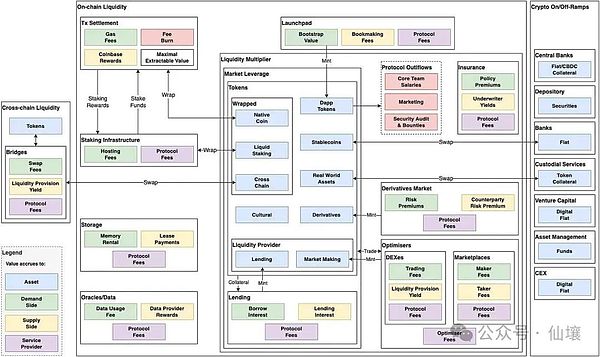
Source: DeFi Value Flows: Understanding DeFi Business Models and Revenues | by Aw Kai Shin
DeFi infrastructure is developing rapidly (Uniswap, Ethena, LayerZero as examples)
In 2022, Dan Elitzer published an article on the inevitability of "Unichain", arguing that the reason for this trend is the inefficiency and value loss in the existing DEX system. As stated in the article, Uniswap traders face three major costs: transaction fees paid to liquidity providers, gas fees paid to Ethereum validators, and MEV costs.
Uniswap announced the launch of its own Unichain in 2024 , aiming to solve problems related to execution quality, user experience and liquidity fragmentation, which enables Unichain to capture more value from its user base and increase application scenarios for UNI tokens. Not only Uniswap, other DeFi protocols have also announced the launch of their own dedicated infrastructure - Fraxtal of Frax Finance, Swellchain of Swell Protocol, Worldcoin's Worldchain, Zerion's Zero Network, etc.
The uniqueness of these facilities is that no entity can control their "value flow", and every participant can participate in building or expanding to maximize the value captured. In the traditional business system , how value is captured by others and how much value can be captured through expansion are very vague, and there is little public information. However, it is different in the crypto field. The protocol is sovereign, and the market is driven only by supply and demand.
In this trend, I think Ethena and LayerZero are the two protocols that capture the most value. Ethena has grown its TVL from 0 to $6 billion in one year, becoming the most successful DeFi project in this cycle. They are preparing to launch their own infrastructure to increase the application scenarios of ENA tokens and build an ecosystem for their stablecoin USDe.
As Ethena's infrastructure implements token deployment through LayerZero's OFT (Omnichain Fungible Token) framework in the future, the protocol's revenue will grow further. In addition, DeFi protocols expand infrastructure by building their own Rollups or deploying them to multiple public chains, where cross-chain security is critical. In this scenario, LayerZero (ZRO) can provide the best experience.
The integration of DeFi and traditional finance is deepening (taking Ondo and Ethena as examples)
In the past, users in the crypto space were limited to anti-government figures and aggressive traders. However, as DeFi's advantages in asset management become increasingly apparent, traditional finance (TradFi) is gradually entering the crypto space. Currently, two major traditional financial groups are slowly integrating into the DeFi ecosystem.
First, there are fintech companies, which have been driving innovation at the traditional financial level within the regulatory framework. The rise of fintech is relatively late - before 2010, mainstream payment methods were limited to bank transfers and cash. The advent of mobile Internet has promoted the development of fintech, and companies such as Stripe, Robinhood and Revolut have emerged one after another, providing better services for payment, trading and asset management.
DeFi protocols also aim to improve the financial system, but outside the regulatory boundaries. The experimental spirit of fintech companies has prompted them to get involved in the crypto field. More obvious examples include PayPal's stablecoin PYUSD launched in the Solana ecosystem, with a TVL of $500 million, and bridge.xyz acquired by Stripe for $1.1 billion. In addition, Robinhood is also preparing to launch a stablecoin, and Revolut is also participating in DeFi activities. These events show that the integration of DeFi and fintech is accelerating.
In addition to fintech companies, traditional financial institutions such as BlackRock and JPMorgan Chase are also actively exploring the crypto ecosystem. Compared with Tether's $5.2 billion in revenue in the first half of 2024, BlackRock's net profit in the same period was only $3.126 billion. This comparison makes traditional institutions also want to get a piece of the pie in the crypto field.
It is worth noting that BlackRock has launched BUIDL, a stablecoin with a source of income from government bonds. Crypto native protocols such as OndoFinance (ONDO) are working closely with financial institutions within the regulatory framework, while protocols such as Ethena have been integrated with BUIDL to provide on-chain users with a wider range of government bond income channels. With the lowering of regulatory thresholds and the continued growth of the stablecoin market, the integration of DeFi and traditional finance will continue to accelerate.
JW: Adoption of consumer applications and application-centric ecological transformation
Portfolio: Pengu , Abstract , MegaETH
The rise of speculation as a product and consumer application
2025 is expected to be a breakthrough year for consumer applications in the crypto space. Historically, the crypto space has always followed a familiar evolutionary pattern: starting with early users represented by fund traders and gradually expanding to a wider audience. We have witnessed this pattern in the development of Bitcoin, stablecoins, and DeFi. Now, the consumer application track has gradually become active in the public eye.
In order for crypto to move beyond just experienced traders competing against each other, the crypto space needs to expand its influence and attract new users and capital to drive the growth of the ecosystem. This evolution is likely to be achieved through more streamlined applications that can take advantage of some of the unique advantages of crypto technology, including memes, SocialFi, NFTs, and Gamefi. I predict that these areas will regain market attention, but in a more mature and complex way than in previous cycles.
It’s exciting to see the industry shift toward developing products that are easy for users to use, whether through memes, NFTs, or AI-related applications, we’re seeing a new wave of applications that effectively leverage the unique advantages of crypto to create a unique user experience.
The AI Agent and DeSci projects , which began to gain traction in 2024 , can be seen as classic cases of speculation evolving into unique tracks and use cases. Users who initially entered the field due to speculation tend to explore broader crypto use cases such as DeFi, stablecoin payments, and prediction markets.
Current market conditions are particularly suitable for mainstream consumer adoption in the crypto space, as the user experience has improved significantly compared to before: wallets are more intuitive and seamless, mobile accessibility has improved significantly, and previous technical barriers around scalability have been largely resolved. These improvements have enabled the crypto market to achieve a user experience close to that of traditional financial services.
As market sentiment moves in a positive direction overall, we may see continued growth in user adoption. In addition, as the Trump administration shifts toward more friendly crypto regulation, the United States may have a more favorable regulatory environment for crypto and catalyze positive regulatory evolution in the global market.
The rise and fall of AI agents
After the emergence of $GOAT at the end of 2024, AI Agent has become the hottest track in the crypto field, and is expected to reach a higher peak in 2025. As we have seen, new technologies are good at capturing the public's imagination and spawning powerful memes. From the metaverse craze to modular blockchains, to today's AI Agents, each wave represents extreme optimism driven by technological innovation and speculative frenzy. It should be made clear here that we are discussing AI Agents in the crypto field, not the traditional AI industry.
There is a key difference between AI Agent and previous tracks. Unlike fields such as DeFi and modular blockchain, which have successfully gained a foothold after their respective bubbles burst and entered the "enlightenment slope" stage based on actual utility and steadily gained adoption, today's AI Agent is more similar to the hype cycle of the metaverse. Both face the same problems: unclear use cases, unclear target users, and value propositions covered by buzzwords.
Looking ahead, although AI Agents may continue to dominate market attention and achieve rapid price increases driven by technology narratives, the field also faces major risks. Without meaningful long-term growth momentum or specific use cases, AI Agents may only decline sharply and it will be difficult to recover. Whether investors in the AI Agent track can make a profit depends on whether they can cash in profits and exit before the bubble bursts.
Dynamic changes between chains and applications
In 2025, the crypto industry may experience a fundamental shift in the traditional relationship between chains and applications. Public chains have long been seen as the center of the ecosystem, but this concept is being challenged as the industry accelerates its transition to an application-driven paradigm. The traditional model of the crypto industry is top-down, with blockchains as the foundation for ecosystem development. Although the highly anticipated public chains will enter the public eye in 2025, including Monad, Bera, MegaETH, and Initia, this may be the last generation of general-purpose blockchains that can be successfully launched.
The future trend of blockchain development is shifting from general public chains to two completely different models: one is to expand mature applications into complete ecosystems like HyperLiquid and Ethena, and the other is successful protocols like Uniswap to launch their own blockchains.
The industry's financing landscape is also evolving with this shift. Community-centric token distribution is becoming increasingly important, with MegaETH successfully reviving the ICO model, and HyperLiquid and Pudgy Penguins' large-scale airdrops also being successful. The focus of such projects has shifted from traditional VC financing to user adoption and community engagement. In particular, mature applications can leverage existing user groups to generate liquidity and network effects when launching their own tokens or chains, reducing reliance on traditional financing channels.
Ingeun: The blockchain infrastructure behind Bitcoin is ready to go
Portfolio: Ethereum, Solana, Ethena, Mantle, EigenLayer, Puffer Finance, Zircuit, EtherFi
In the bull market of 2024, the price of Bitcoin has risen more than 2.4 times from its previous low. Although the four-year halving cycle of Bitcoin and Trump's re-election as US President have brought positive factors, I don't think this is the main driving force for Bitcoin's growth, but the gradual change in the public's perception of cryptocurrency, the further development of the blockchain industry, and the improvement of the participation of traditional financial forces in the crypto ecosystem .
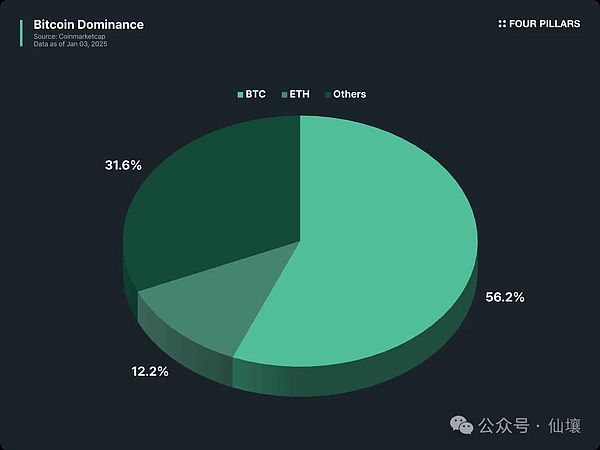
As a bellwether of the blockchain industry, the rise in Bitcoin's price will naturally drive the rise of other cryptocurrencies. However, precisely because Bitcoin is in a dominant position, capital is highly concentrated on Bitcoin, and capital redistribution in other areas of the crypto industry has not yet fully occurred. In past bull markets, Bitcoin's price increases were usually accompanied by a decline in its dominance as capital flowed into Altcoin.
Although many people are still focusing on the continued rise of Bitcoin, capital is expected to be reallocated to other projects such as Ethereum and other public chains, as well as L2 in 2025. These projects have been quietly preparing under the light of Bitcoin, and as capital flows in, they may shine this year. My investment portfolio follows this idea, and below I will explain my views on some excellent projects.
Critical Infrastructure Chains: Ethereum and Solana
Ethereum is facing considerable challenges in this round of bull market. Although Ethereum holders have high expectations for it and ambitiously announced the Beam chain and its future roadmap at the 2024 Devcon conference, the development of Ethereum has been overshadowed by the continued progress of new public chains led by Solana. The comparison with the latter has made Ethereum quite difficult in 2024, which is fully reflected in its price performance.
Judging from the ETH/BTC price trend, Ethereum has been on a downward trajectory recently. While it still maintains its position as the second largest cryptocurrency, second only to Bitcoin, its momentum has clearly weakened. Despite this, I believe Ethereum is about to rebound. Although many public chains are vying for Ethereum's throne, Ethereum still has an overwhelming advantage in scale. Among its competitors, Solana is the most powerful opponent, but Ethereum's market capitalization (as of January 14, 2025) is still more than 4 times that of Solana, and the assets locked in the Ethereum DeFi ecosystem are also more than seven times that of Solana.
In addition, Ethereum is the first crypto asset to be approved for an ETF after Bitcoin, making it easier for traditional financial institutions and institutional investors to participate. The inflow of funds through Ethereum ETFs has steadily increased, with net inflows reaching a record high of $2.08 billion in December 2024, more than double the $1 billion in November. It is worth noting that BlackRock's ETHA fund had an inflow of $1.4 billion in December, while Fidelity's FETH fund had an inflow of $752 million.
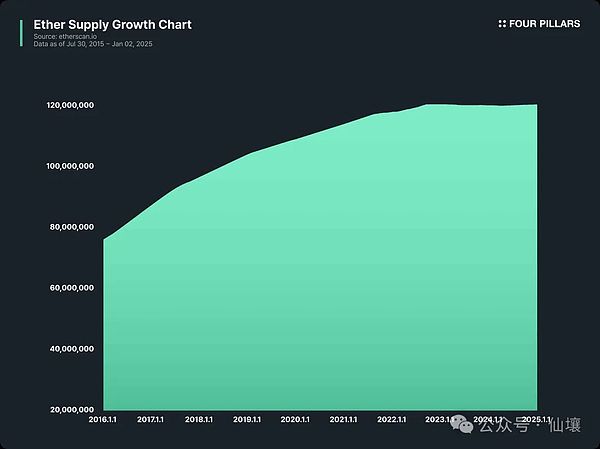
Ethereum continues to strengthen its foundation both internally and externally. The previously unstable Layer2 ecosystem is now mature and functional, and Ethereum's emphasis on ZK is growing steadily with the support of many projects. At the same time, Ethereum's Restaking service originates from the consensus system within its ecosystem, has a unique positioning, and is also constantly improving.
One of the biggest concerns of Ethereum investors is that there is no fixed cap on the amount of ETH, but this issue has been largely alleviated. Since the London hard fork in August 2021, the issuance of Ethereum has decreased, and part of its current circulating supply is in a deflationary state, which has contributed to the stability of ETH prices.
Is Ethereum in crisis at the beginning of 2025? My answer is yes. But crises often come with the best opportunities. Ethereum has introduced the concept of a global computer that Bitcoin cannot achieve structurally, and it continues to improve itself. In 2025, Ethereum will overcome its own crisis and prove its value as a trump public chain.
Solana, Ethereum’s strongest competitor, is actively catching up with the former in all areas of the blockchain ecosystem. Solana’s ecosystem has grown to a considerable scale, unparalleled in the public chain outside of Ethereum, and has a unique scale advantage.
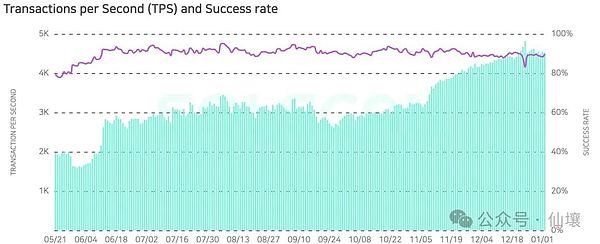
Source: Solscan
Solana prioritizes performance and user-friendliness over decentralization like Ethereum. While this means Solana’s operating structure is slightly more centralized, it is able to achieve TPS of several thousand transactions per second, which provides Solana users with a nearly seamless environment without taking unnecessary risks.
In addition, Solana leverages its large developer and user community to stay at the forefront of technology and the market. In the early days of this bull market, Solana led the trend of Meme coins and surpassed other chains through faster cultural adoption. Recently, Solana has kept up with the AI trend by organizing activities such as AI hackathons, demonstrating its ability to continue to lead new trends.
Unlike the narrative development of Ethereum, Solana has been reshaping the crypto space’s view on decentralization. It raises a fundamental question: if the high degree of decentralization advocated by Ethereum ultimately has a negative impact on users, should decentralization be pursued at all costs ?
With Ethereum as a formidable rival above and various L1 chain challenges below, Solana’s next move is crucial. As it continues to forge its own unique path, I will continue to closely monitor how Solana develops in the crypto space.
Continued Growth of the Restaking Ecosystem
“Restaking allows users to reuse staked assets, providing additional economic security for multiple public chains or applications, allowing staked assets to be recycled, improving scalability and liquidity, while earning additional rewards.”
As mentioned above, Restaking is a financial engineering solution that reuses staked assets to improve scalability and liquidity, achieving significant growth in 2024.
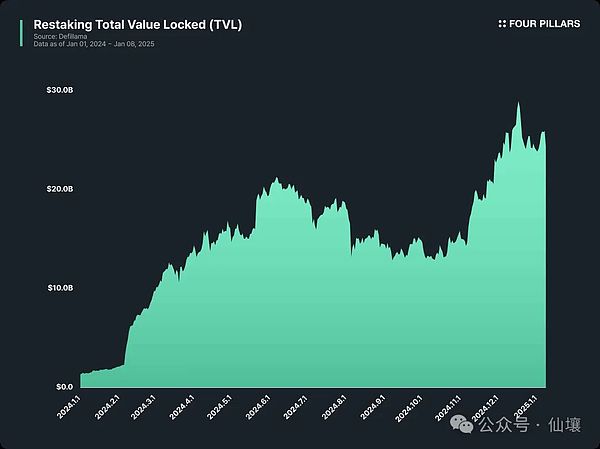
It is worth noting that EigenLayer, a Restaking ecological facility, as well as platforms such as EtherFi, PufferFi and Zircuit, have attracted a lot of funds and promoted the expansion of the Restaking market.
If the keywords for Restaking in 2024 are “Restaking debut” and “Focus on Ethereum”, then the keywords for 2025 may be “The emergence of more Restaking participants” and “The expansion of Restaking to other L1 chains”.
Ethereum can be said to be the birthplace of Restaking, and competition among infrastructure providers such as EigenLayer, Symbiotic and Karak is intensifying. Although Symbiotic and Karak are new entrants to Eigenlayer and currently manage less staking assets than EigenLayer, they are actively carving out their own niche markets.
For example, Symbiotic supports Restaking of multiple assets such as Ethena (ENA) to attract more deposits, while Karak makes itself more unique and competitive by supporting cross-chain asset staking (including Arbitrum, Mantle, and BSC).
Therefore, we may witness fierce competition among Restaking providers within the Ethereum ecosystem in 2025. At the same time, the Restaking narrative may expand to ecosystems outside of Ethereum and enter a new growth phase. Among them, BTC and Solana are key ecosystems for the expansion of the Restaking narrative.
Bitcoin, with its unparalleled total asset size, can use Restaking as a means to generate additional profitability on other blockchains. Babylon is a project that uses Bitcoin staking and Restaking mechanisms to enhance the security of other PoS chains. It is worth noting that Babylon allows BTC to be pledged directly on the Bitcoin network without the need for bridging or mapping encapsulation, providing higher usability and simplicity.
Solana's high transaction speed and low fees have promoted the development of many Restaking services, such as Jito and Solayer. As a well-known staking provider in the Solana ecosystem, Jito has expanded its expertise to the Restaking field, providing stable and reliable Restaking solutions based on its mature staking technology. Similarly, Solayer, inspired by EigenLayer, focuses on improving convenience while further promoting the development of the Solana ecosystem.
In 2025, competition in the Restaking track will intensify not only within Ethereum, but also in other L1 chains such as Bitcoin and Solana. Restaking will continue to evolve as a key innovation in the blockchain ecosystem.
Blockchain projects worth watching in the new year
Many new projects emerged in 2024. In 2025, there will be a competition between those projects that laid a solid foundation in 2024 and those that emerged this year. From this perspective, we can focus on Ethena and Mantle.
Ethena stands out as one of the fastest growing projects among USD stablecoins, achieving significant growth in 2024 through a unique high-yield strategy, secure collateral management backed by BlackRock BUIDL, stability achieved by US Treasuries, and a comprehensive expansion plan for the Ethena network.

Source: The Verge of Crypto Dollar War and Strategy of Ethena (Feat. UStb, Network) | 4Pillars
Ethena's USD stablecoin, USDe, stands out by providing clear returns to users through staking rewards, delta-neutral market strategies, and liquidity stablecoin returns. This has led to a large influx of funds from other USD stablecoins such as USDT and USDC into USDe. As use cases continue to grow and fintech companies increasingly adopt stablecoins, their dominance in the market should continue. Based on such trends, the growth of Ethena and USDe should also continue in 2025.
Mantle is expanding its influence by launching Mainnet V2, offering staking rewards, and distributing airdrops of other tokens in 2024. These efforts have enabled Mantle to expand its user base and establish a strong presence. On the technical side, Mantle is working with Succinct to explore a model that transitions from Optimism rollup to ZK rollup. In addition, Mantle is working with Chainlink to integrate the Chainlink cross-chain interoperability protocol CCIP, laying the foundation for upgrading the Mantle ecosystem to a multi-chain ecosystem.
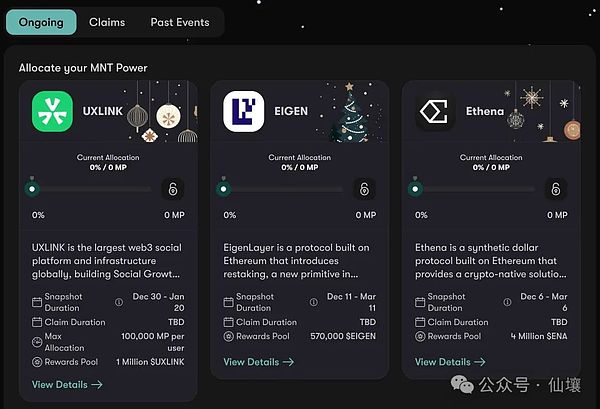
Source: Mantle Reward Station
From an ecosystem perspective, Mantle has solidified its partnership with Bybit, expanding Mantle's use cases and increasing its user base. In addition, Mantle's staking program allows users to earn MNT Power (MP) as rewards, which can be used to participate in other airdrops, thereby promoting active user participation. These initiatives have made Mantle's promotion in the market very effective, and I expect this momentum to continue until 2025.
Mantle has a close relationship with Bybit. Bybit is an exchange that is rapidly catching up with Binance, and Mantle's cooperation with Bybit has laid a good foundation for its further growth. The increase in the number of Mantle holders may bring more activity on the mainnet, forming a positive feedback loop that is beneficial to the entire Mantle ecosystem. Under this trend, 2025 is expected to be a year of significant expansion of the Mantle ecosystem.
Eren: New roles in the on-chain market and the development direction led by the AI Agent boom
Portfolio: Virtuals Protocol, Axal, Tetsuo, Redacted Research and Development
Catalyst for retail capital inflows: On-chain small-cap transactions
The inflow of on-chain liquidity to small and medium-sized assets is expected to accelerate further. Compared with large-cap assets listed on centralized exchanges, these assets will create more diversified opportunities, as high expected returns have become a key driver for attracting retail investors to enter the crypto market. This model of issuing assets on the chain has already appeared in the memecoin cycle last year. The overvaluation of VC coins has led to the so-called "high FDV" phenomenon, and the expected return of VC coins has declined. Many people have shifted their attention from VC coins on CEX to on-chain memecoin transactions.
In this context, perhaps the most impressive thing about last year was the sharp rise in memecoin prices, such as Chillguy and Moodeng. Phantom Wallet ranked among the top app store downloads, which also shows that even users with no previous on-chain experience are now actively using on-chain wallets and tools such as Moonshot to trade high-return, high-risk assets such as memecoin.
This scenario marks an important turning point in crypto adoption. Although we previously judged that attracting and carrying on-chain users through infrastructure development and new applications is the key , the unique speculation of the crypto market and its high return expectations can undoubtedly become a catalyst for promoting crypto adoption.
Therefore, a more obvious change in 2025 than before will be that on-chain small and medium-sized market value asset transactions will no longer be limited to old users, but will become a powerful catalyst for the inflow of scattered funds. The resulting trend is worth paying attention to. For example, the proportion of DEX trading volume relative to CEX is expected to continue to increase, and new narratives suitable for creating small and medium-sized market value assets may continue to emerge, just like the AI Agent and DeSci tracks.
In addition, project building methods such as Daos.Fun integrating the financing process outside of the Pump.fun model are expected to become mainstream, and projects must ensure a fair launch.
In the wave of AI agents, which ones will survive and which ones will die?
Last year, AI Agents were the most prominent narrative, accounting for over 70% of the attention in the entire market. Even today in 2025, the AI Agent cycle continues, and the combination of crypto and AI Agents will continue to be a key topic, as AI is considered a keyword in almost all industries. However, assuming that the crypto market gradually fades and enters a long-term correction phase, we expect that once the interest driven by short-term speculative demand fades, only a portion of AI Agent projects will survive, while another batch will die out.
Under such market conditions, the projects that can survive are those that go beyond technical imagination and have novel ideas, and are not lacking in practical value. Virtuals Protocol is a typical example. Considering the long-term viability of combining encryption with AI Agent in creating sustainable use cases and businesses, Virtuals Protocol provides integrated services for the AI Agent development framework and AI Agent token creation launch platform, which will ensure its unique position as the foundation layer of the ecosystem in the AI Agent market.
It is worth noting that $VIRTUAL tokens are traded in pairs with all AI Agent tokens and are consumed like base currency when people use tools such as the launchpad. This token model of "accumulating value from all platform interactions" is a key foundation to support the sustainable growth of Virtuals Protocol.
At the same time, from the perspective that the AI Agent ecosystem must generate actual profits, the combination of DeFi and AI Agent seems to be the most reasonable path. Transaction fees, lending spreads, and income generated through structured products in DeFi protocols have been clearly verified to have PMF space.
Therefore, instead of allowing AI Agents to develop new businesses in areas such as games or social networking, it is better to introduce them as a solution to solve the inefficiencies of DeFi. In particular, AI Agents as autonomous portfolio management tools, natural language-based user experience improvements, and automated trading tools are expected to become key use cases leading the integration of AI Agents with crypto.
Ponyo: AI, DeFi, Hyperliquid
Portfolio: Pudgy Penguins , Ethena, FARM, MIZUKI
The three major trends in the crypto space this year are:
(1) Integration of encryption and AI
(2) DeFi renaissance driven by fee switch model activation
(3) The resurgence of airdrops and ICOs driven by Hyperliquid.
The first trend has already attracted a lot of attention from leading AI research analysts, and this section will delve deeper into the latter two topics.
DeFi Renaissance: The Fee Switch Revolution
Today, most DeFi tokens are used only as governance tools. While this is consistent with the idea of decentralization, as governance tools without empowerment, tokens provide limited actual economic value to holders. Despite the strong operational performance of many DeFi protocols, their token prices remain undervalued, reflecting the limited utility of these assets.
Against this backdrop, the fee switch model — which distributes a portion of a protocol’s revenue directly to token holders — has long been considered a potential catalyst for revaluing DeFi tokens and making them more attractive to investors.
However, the implementation of such mechanisms has been repeatedly hindered by regulation. The U.S. Securities and Exchange Commission (SEC) classified revenue distribution tokens as securities, placing a significant compliance burden on the protocol. Uniswap has attempted to activate the fee switch feature multiple times through three separate governance votes, but has been blocked by concerns about regulatory risks. Notably, influential stakeholders such as a16z opposed these proposals, highlighting the hidden dangers of greater diversification within the DeFi space.
The situation changed dramatically after Donald Trump won the presidential election in 2024. With the Republican Party in control of the White House, Congress, and the Supreme Court, the outlook for crypto policy has improved significantly. The new administration has expressed its intention to position the United States as the world's "crypto capital" and has even explored the inclusion of Bitcoin in its strategic reserves.
This policy shift is reflected in the appointment of many key positions. Paul Atkins, as the new SEC Chairman, and David Sacks, as the White House Crypto Policy Advisor, introduced a more constructive approach. Initiatives such as the removal of "Chokepoint 2.0" and the establishment of a dedicated Crypto Advisory Committee are aimed at the urgent regulatory clarity issues that need to be addressed. The departure of Gary Gensler and the subsequent change in the SEC's position have significantly eased the compliance pressure on market participants.
Driven by this optimism, several cutting-edge DeFi protocols are actively rethinking fee switch models. Well-known protocols with proven revenue streams like ENA, UNI, AAVE, and RAY are participating in governance discussions to implement revenue sharing mechanisms . As regulatory clarity gradually emerges, these protocols are expected to anchor their token economics on sustainable revenue distribution, thereby narrowing the gap between speculative value and fundamental financial metrics.
This evolution marks a new dawn for the DeFi renaissance, which, unlike the DeFi Summer explosion in 2020 driven by liquidity mining and a surge in innovative products, prioritizes sustainable models, continued revenue generation, and revaluation of DeFi tokens. As these changes continue to occur, DeFi protocols have the opportunity to consolidate their competitive advantage over the traditional financial system and provide decentralized solutions based on real economic interests.
Airdrops and ICO resurgence driven by Hyperliquid
One of the defining moments of the market in 2024 was the rise of Hyperliquid. After the TGE on November 29, the HYPE token exceeded $34 billion in FDV within a month, and as of January 14, 2025, its trading valuation was approximately $20 billion. However, Hyperliquid's influence is far more than just valuation. Its firm commitment to the community-first philosophy has set a precedent for the development trajectory of Web3 projects in the next few years, potentially redefining industry standards.
Hyperliquid's decision to operate entirely through self-funding breaks the traditional model. By ensuring equal opportunities for all participants and refusing to allocate tokens to private investors or market makers, the project directly challenges the common practice of inflating valuations through VC financing. The latter often puts retail investors under pressure to sell tokens at high prices. Hyperliquid's model forces the industry to re-examine token allocation standards and move the industry towards a more fair and transparent direction.
As we head into 2025, a renaissance of community-based funding models seems inevitable. While the ICO boom of 2018 was marred by scams and regulatory ambiguity, clearer regulation under the Trump administration could restore trust to the market. Platforms like Echo and Legion are already taking advantage of this shift, which also signals a broad return to the decentralized ideals of Web3.
Hyperliquid has also reshaped the way people think about airdrops. In the traditional model, airdrops have been criticized for failing to foster long-term community belief and are usually short-term incentives with limited impact. Some project founders are skeptical of them, believing that they are cost-ineffective marketing activities that accelerate user churn rather than promote retention. Indeed, many users participate in airdrops only to get a one-time reward and then quickly exit. The market generally believes that airdrops are an ineffective and unsustainable marketing tool.
However, Hyperliquid challenges the narrative of the traditional model of short sellers by allocating 70% of the HYPE token supply to the community and demonstrating how airdrops can be used to share rewards and promote growth together. By prioritizing the community, Hyperliquid demonstrates the potential of airdrops to build loyalty and long-term engagement. Inspired by this success, other projects have begun to adopt similar strategies. For example, Azuki recently announced that it would allocate 50.5 ANIME tokens to the community. Therefore, the airdrop model is expected to revive and may become one of the defining themes of 2025.
Hyperliquid's success is due to its commitment to product quality. By achieving PMF before token issuance, Hyperliquid prioritizes practicality and community trust over speculative gains. This stra








